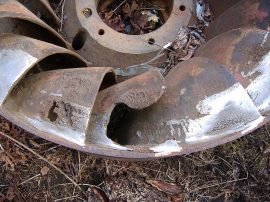
Cavitation is a phenomenon in which rapid changes of pressure in a liquid lead to the formation of small vapor-filled cavities, in places where the pressure is relatively low.
When subjected to higher pressure, these cavities, called “bubbles” or “voids”, collapse and can generate an intense shock wave
Cavitation is a significant cause of wear in some engineering contexts. Collapsing voids that implode near to a metal surface cause cyclic stressthrough repeated implosion. This results in surface fatigue of the metal causing a type of wear also called “cavitation”. The most common examples of this kind of wear are to pump impellers, and bends where a sudden change in the direction of liquid occurs. Cavitation is usually divided into two classes of behavior: inertial (or transient) cavitation and non-inertial cavitation.

 Português
Português Español
Español







